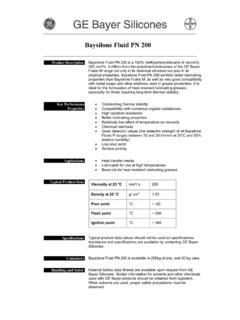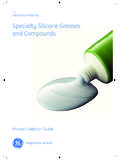Transcription of BAYER SILICONES BAYSILONE FLUIDS M - DC …
1 This information and our technical advice whether verbal in writing or by way oftrials are given in good faith but withoutwarranty and this also applies whereproprietary rights of third parties areinvolved. Our advice does not release youfrom the obligation to verify the informa-tion currently provided especially thatcontained in our safety data and technicalinformation sheets and to test ourproducts as to their suitability for theintended processes and uses. Theapplication use and processing of ourproducts and the products manufacturedby you on the basis of our technicaladvice are beyond our control and there-fore entirely your own responsibility. Ourproducts are sold in accordance with thecurrent version of our General Conditionsof Sale and on the Internet: no.: AI 12 613 e Edition: 7. 96 Printed in Germany E BAYER AGInorganicsBusiness GroupSilicones Business UnitBaysilone MarketingSectionD-51368 LeverkusenBAYERSILICONESBAYSILONEFLUIDS MPolymeric dimethyl siloxanes SILICONESBAYSILONEFLUIDS M BAYERC ontentsPageViscosity.
2 The effect of temperature3 The effect of pressure3 Shear behaviour3 Pour points, flash points, fire points, ignition points4 Vapour pressure4 Density5 Thermal stability5 Thermal conductivity, thermal capacity, specific heat5 Coefficient of expansion, specific volume6 Compressibility6 Surface tension7 Refractive index7 Dielectric performance7 Solubility7 The solubility of gases in BAYSILONE FLUIDS M8 Neutralisation value8 Lubricating and slip properties8 Chemical stability / Compatibility with materials8 Storage stability9 Miscibility and viscosity adjustment9 Physiological behaviour9 Special commercial and processing formulations9 Grades10 Purity requirements and tests10 Physiological and toxicological properties10 Storage10 Chemical composition12 Properties and reactions12 Oxidation12 Substitution12 Addition12 Characteristics12 Solubility12 Storage stability12 Use12 Important note13 Figures 1 to 714 XBaysiloneFluids MBaysiloneFluids MPHB aysiloneFluids MH 15 Figures2 BAYSILONE FLUIDS M are a group of liquid, water-clear polydimethyl siloxanes.
3 They differfrom organic compounds in both their physicaland chemical properties which, singly or incombination, have won BAYSILONE FLUIDS aspecial place in technological properties are:High and low-temperature stabilityA low pour pointMinimum effect of temperature and pressureon viscosityLow vapour pressureFavourable dielectric characteristics littleinfluenced by temperature and frequencyHigh interfacial tension to water and organicpolymersHigh surface activityHigh compressibilityChemical and physiological inertnessAs a result of these properties, BaysiloneFluids M are eminently suitable for use asHeat transfer mediaHydraulic fluidsLiquid dielectricsWater repellentsPolishesMould release agentsLubricantsAntifoamsDamping fluidsAuxiliaries for the manufacture of cosmeticsand pharmaceuticalsThe range of BAYSILONE FLUIDS M comprisesvarious grades which differ in their viscosityand in related properties. The adjacent listconstitutes a survey of the entire range ofBaysilone FLUIDS addition to the grades listed here, BaysiloneFluids are available, if required, in other viscos-ities, provided that large or regular suppliesare involved.
4 Low-viscosity BAYSILONE FLUIDS Mare available down to a minimum viscosity s 1(cSt). Please ask for furtherinformation in individual )The values correspond to the nominal viscosityin mm2 s 1at 25 C (DIN 53 019).Intermediate values are obtained by blendingin accordance with the blending chart shownon p. 14 (Fig. 1). More detailed information onblending techniques and the use of the chartare to be found on p. 9 of this pamphlet. Tem-perature has very little effect on the viscosityof BAYSILONE FLUIDS M. The graph in Fig. 2 (p. 15) shows the effect of temperature onBaysilone FLUIDS M as compared with mineraloils of similar ViscosityViscosityFluid M1)tolerancee%class310510nlow-viscosity1 0102010501010053505nmedium-viscosity5005 1 00051 50055 000510 000512 500530 0005nhigh-viscosity60 0005100 0005300 00010500 000101 000 00010nultrahigh-viscosity2 000 00010 SILICONESBAYSILONEFLUIDS M BAYER3 The viscosity of BAYSILONE FLUIDS M, unlike thatof mineral oils, is scarcely affected by pressure of 2,000 bar at 25 C causes theviscosity of mineral oil to increase 50 to 5,000times, depending on the grade, whereas theviscosity of BAYSILONE fluid M 1000, forexample, increases only 14 times under thesame conditions.
5 Even when subjected toextreme pressures, at which mineral oilssolidify, BAYSILONE FLUIDS M remain 3 (p. 16) shows the viscosity of BaysiloneFluid M 100 and M 1000 in graph form atdifferent temperatures as a function FLUIDS M act as Newtonian FLUIDS atviscosities below 1000 mm2 s 1up to ashear rate of over5 103s 1. At higher viscos-ities the pseudoplasticity is noticeable even atlow shear rates. If the temperature of a fluid isincreased, the range of Newtonian behaviourshifts to higher shear 4 (p. 17) shows the viscosity of BaysiloneFluids M as a function of the shear :The effect oftemperatureBaysilone Viscosity in mm2 s 1(cSt) atFluid M 80hC 60hC 40hC 00062035029020015012595755001 3008505004002902101651401101 0002 9001 8501 0007505204003002301905 0008 5005 0003 8002 8002 0001 6001 2001 00012 50020 00012 5009 8007 0005 1004 0003 0002 40030 00050 00030 00022 00016 50011 5008 5007 0005 00060 000100 00060 00042 00030 00020 00015 50011 0009 000100 000180 000100 00075 00055 00040 00030 00022 00017 000300 000500 000300 000200 000175 000133 000100 00078 00062 0001 000 0002 000 0001 000 000750 000520 000390 000280 000210 000160 000 The effect of pressureShearbehaviour5 The densities of BAYSILONE FLUIDS M at 25 Care between and In other wordsthey do not greatly differ from that of density of the FLUIDS increases with viscos-ity.
6 The effect of temperature on density isapproximately linear. Measurement of thedensity between 40 C and 175 C producedthe figures shown in the table the presence of air, BAYSILONE FLUIDS M havepractically unlimited stability at temperaturesof up to 150 C. The FLUIDS will also stand upwell to higher temperatures if the access of airis restricted, e. g. by reducing the exposedsurface of the fluid or by sealing off the fluidcompletely using a narrow pressure-equalisingconnection pipe. Where air is totally excludedby using the FLUIDS in completely enclosedsystems or in an inert atsmosphere, e. a nitrogen or carbon dioxide cushion,the FLUIDS may even be exposed to temperaturepeaks of approx. 300 C. In this case theviscosity gradually decreases, whereas it willgradually increase at elevated temperatures ifthe access of air is not thermal conductivity of BAYSILONE FLUIDS Mis not affected by temperature. Even the levelof viscosity has only a slight effect.
7 Thus,although the coefficient of thermal conductivity increases somewhat from the low to themedium-viscosity oils, it undergoes no furtherchange when the high-viscosity grades following values for the coefficient ofthermal conductivity were determined atboth 25 C and 250 fluid MW K 1 m ignition temperatures of BAYSILONE FluidsM are above 400 C. They therefore belong toignition group G FLUIDS M are characterised by thefact that they retain their liquid state over anunusually wide range of temperatures. Thepour point of certain types of BAYSILONE FluidsM is below 100 C. Because of the highmolecular weight structure, the boiling pointscannot be determined at all at atmosphericpressure. The pour, flash and fire pointsbecome higher as the viscosity of BaysiloneFluids M vapour pressure of medium and high-viscosity BAYSILONE FLUIDS M is very low. Attemperatures between 25 C and 175 C, it isbetween 10 5and 10 4mbar.
8 Only the low-viscosity grades possess a noticeably highervapour pressure. The flash point can be takenas an indication of order to determine the volatile constituentsof BAYSILONE FLUIDS M at 250 C, the NoackTest(heating a 65 g sample for one hour atatmospheric pressure reduced by 20 mbarand at 250 C) was used. The weight losseswhich occurred were as follows:Noack Test for BAYSILONE FLUIDS M Weightat 250hC (as per DIN 51581)loss %Baysilone50less than M100less than than than 000less than 000less than points,flash points,fire points,ignition pointsBaysilone fluid MPour point C belowFlash point C aboveFire point C aboveDIN 51597 DIN 51376 DIN 5137635102050*50 EL1003505001000500012 50030 00060 000100 000300 0001 000 0001101602302903503503703803803903903903 9039032040032040062120170240280300300315 315320320320320320 100 100 90 70 60 60 50 50 50 50 50 50 50 50 50 40 *= dielectric cooling agent for transformers;see BAYSILONE M 50 EL brochureVapourpressureBaysilone fluid MDensity in g cm 3 000 ,thermalcapacity,specific heatThermalstability7 The surface tension of BAYSILONE FLUIDS M isabout 19 21mN m 1, and is thus extremelylow.
9 It shows a very slight increase from thelow-viscosity to the high-viscosity refractive index of BAYSILONE FLUIDS M risesfrom nD25= for M 3 through forM 20 until it reaches a virtually constant valueof for M 1000 and of their satisfactory dielectriccharacteristics, BAYSILONE FLUIDS M are usefuldielectrics. Measurements have revealed thatthe dielectric strength, volume resistivity,dielectric constant and dissipation factor arelittle affected by temperatures over a widerange. Similarly, there is very little change inthe dielectric constant and the dissipationfactor over a frequency range from 102to 107 Hertz. The relevant data for BAYSILONE fluid M350 can be seen in Figs. 6 and 7 (p. 19 andp. 20). The dielectric characteristics of otherBaysilone FLUIDS M are listed in the followingtable and are also contained in the BaysiloneM 50 EL determining the mean specific heat c ofBaysilone FLUIDS M 50 to M 12500, there wereno appreciable differences between the individ-ual FLUIDS ; the same holds true for the thermalcapacity W20.
10 The relationship between thevalues obtained is shown in the table mean cubic expansion coefficient ofBaysilone FLUIDS M in the range 25 C to 175 Cis between 99 and 111 10 5 K 1. The differ-ences are slight among the individual types offluids; a slight increase in the coefficients ofexpansion is only observed towards the volume Vt taken up by a given quantity oftinhCcinJ g 1 K 1W20in J g m at a temperature t, can be calculatedby means of the equationVt= m Vspec.(t).The specific volume Vspec.(t) of BaysiloneFluids M is given below for certain tem-peratures. Fig. 5 (p. 18) shows the volume of BAYSILONE FLUIDS M as a function of volume of BAYSILONE fluid M 1000decreases by 15% under a pressure of3,500 bar, and by about 30% under a pres-sure of 25,000 bar. The low-viscosity fluidshave even higher compressibility. As can beseen from the values given below, thecompressibility is relatively high; BaysiloneFluids M are therefore suitable for use in fluidspring fluid MAdiabaticcompressibility Kadin m2 N 1measured at 10 10 10 10 111 10 11 Coefficient ofexpansion,specific volumeCompress-ibilityBaysilone fluid M Mean cubicSpecific volume in cm3 g 1atexpansion coeffi-cient 10 5 K 1 000 solvents for all BAYSILONE FLUIDS Mare aliphatic and aromatic hydrocarbons,higher alcohols, ethers, esters and chlorinatedhydrocarbons, e.




